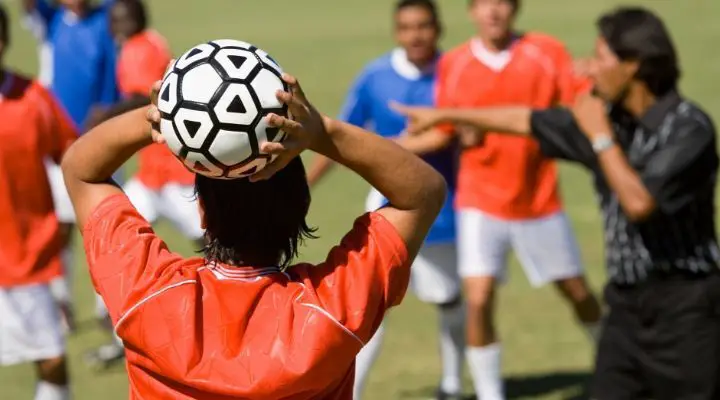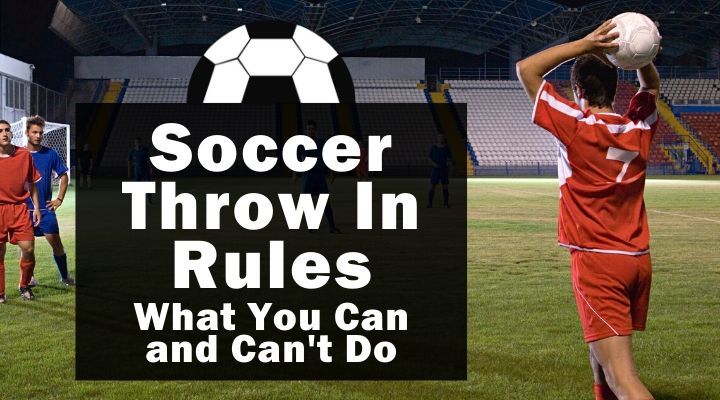Soccer Throw In Rules: What You Can and Can’t Do
A central part of soccer, throw-ins are used to restart the game when the ball has crossed over the touchline and exited the field of play.
While mastering how to do a throw-in is a fundamental skill, it’s just as important to know the soccer throw in rules so that you understand what you can and can't do.
As every soccer player knows, there’s nothing more embarrassing than committing an infraction and having the referee call a foul throw because you took it incorrectly or overstepped the line.
Getting it right time and time again is key, and this is highlighted by the fact that on average, there are between 40 and 50 throw-ins during any Premier League match.
To help you master the soccer throw in rules, let's take a look at what you can and can't do when lining up to take a throw in soccer.

Soccer Throw In Rules and Procedures
While getting the technique right and throwing the ball accurately and powerfully are all important components of taking the perfect throw-in, you also need to keep in mind some simple rules if you don't want to commit an infraction.
Thankfully these are relatively simple to remember, and so in no time at all, you'll find yourself throwing the ball to a teammate without having to stop and think about the rules.
Let's first look at the procedure you go through to take a throw-in before later looking at some of the possible infringements that you'll want to avoid.
First of all, a throw-in is awarded when the whole of the ball crosses over the touchline and out of the field of play. This can either be on the ground or in the air and play is restarted from where the ball exited the pitch.
The throw-in goes to the opponents of the player who last touched the ball before it went out.
To take the throw-in, the player must face the field of play and have part of each foot touching the ground when they release the ball.
While their feet may touch the touchline, they’re not allowed to overstep it.
Otherwise, a foul throw will be called.
When taking the throw-in, the player must have both hands on the ball. Starting from behind their head, the ball should pass up and over their head for it to be a proper throw-in.
As soon as they release it, the ball becomes back in play and the game can restart.
Once play has resumed, the player who took the throw isn’t allowed to touch the ball again until it has touched or been touched by any other player.
While there are no offsides from throw-ins, a player can’t score directly from a throw; it needs to touch or be touched by someone before going into the goal for it to count.
When a throw is being taken, an opposition player may stand no closer than 2 metres from the point where the throw-in is being taken. Players from the same team may stand closer than that, however.
If a player fails to abide by these rules and takes the throw incorrectly, then a foul throw is called. This then means that they lose the ball and the throw is instead taken from the same spot by the opposing team.
To avoid this scenario, let's now take a look at some of the possible infringements that can arise around throw-ins.

Throw In Infringements to Avoid
Committing a foul throw is embarrassing for any soccer player.
Coaches are liable to be furious at you for giving the ball away so cheaply, so it’s well worth taking a little bit of time to go over the following infringements so that you don't commit one yourself.
The main reason that a foul throw is called is when the player taking the throw-in fails to follow the correct procedure.
This means that:
(1) They cross the touchline with their foot or feet when taking the throw.
(2) They fail to keep both feet on the ground when taking the throw.
(3) They don't keep both hands on the ball when they throw it.
(4) The ball doesn't pass up and over their head before they release it.
(5) The ball bounces before entering the field of play (this may happen when they attempt to throw the ball down the line but misjudge the angle and distance).
In any of these scenarios, the referee may whistle for a foul and humiliatingly award the throw-in to your opponents instead. So you really want to avoid committing any of these basic errors.
In addition to this, the referee may ask you to retake the throw if you take the throw-in too far away from the point where the ball exited the field of play.
They could also call for it to be retaken if an opposing player fails to respect the 2-metre distance or distracts or impedes the throw-in from being taken in an unfair manner.
If this persists or is serious enough, the player committing the infringement may be awarded a yellow card for their unsporting behaviour.
A yellow card may also be awarded to the player taking the throw if they waste time and take too long to throw the ball.
Besides holding on to it too long, the player may also do this by appearing to take the throw, only to suddenly leave it for another teammate to take.
Both of these methods are considered unsporting and the referee may dole out a yellow card for such behaviour.
As we mentioned above, the player taking the throw may not touch the ball once it has re-entered the field of play until it touches another player.
If this occurs then an indirect free kick is awarded to their opponents.
Likewise, a goal can’t be scored at either end directly from a throw-in; it has to touch someone before entering the net.
If the ball ends up directly in the opposition's goal, a goal kick is awarded.
If the ball somehow ends up in the player taking the throw's own goal (if they threw it back to the keeper and they misjudged it for instance) then a corner is awarded.
Goalkeepers are also not allowed to pick up or handle the ball directly from a teammate's throw-in. This means they also can't first touch it with their feet before picking it up.
As such, they need to either kick it away or pass it to a teammate with their feet. If they accidentally pick it up in their penalty area, an indirect free kick is awarded.
If the same thing occurs outside of the penalty area, then a direct free kick is awarded instead. They may also receive a yellow card in this situation.

Conclusion
Taking a throw-in is pretty simple.
There's really no excuse for getting it wrong and committing a foul throw.
If you stick to the soccer throw in rules, keep your feet on the ground, throw the ball up and over your head, and avoid the aforementioned infringements, you shouldn't have any problems at all.
By mastering your technique using a variety of throw in drills to practice, you'll be able to get it right time and time again without needlessly conceding possession to your opposition.

